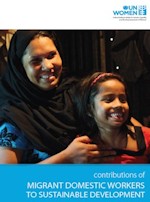This paper focuses on international migrants, namely the women migrant domestic workers who cross borders in search of decent work and sustainable livelihoods. Women represent half of the world’s migrants, and 83 percent of the 52-100 million domestic workers worldwide. For these women, migration is both a personal and family survival strategy. Feminization is more than just numbers in official migration statistics. It refers to the features that define women’s migration, such as the concentration of women in temporary labour migration; their likelihood to migrate via undocumented channels, at risk of trafficking and smuggling; their predominance in the low-wage and low-status job of domestic work – considered “women’s work” – that remains largely hidden in a shadow or informal economy; and the intersecting forms of discrimination(s), harassment and abuse they face throughout the migration cycle (pre-departure, in transit, on-site in destination countries, and on return to origin countries). Additionally, the households and communities, especially children and family members who are left behind by these women, suffer some of the costs of migration, and face a growing “care crisis” at home.
View online/download
Order printed/published version
Languages available in print
English
Bibliographic information

